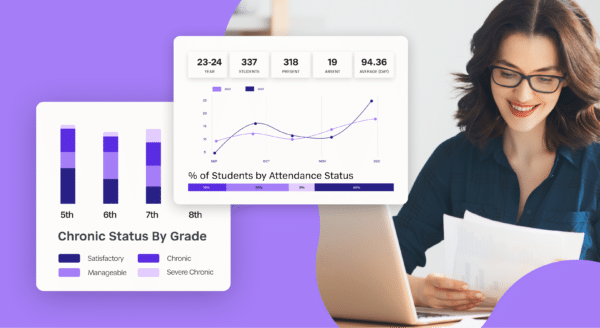
Featured Resource
Why Over Half of California School Districts Trust SchoolStatus
Read More >Join Mission: Attendance to reduce chronic absenteeism in 2025-26! >> Learn How <<





Chronic absenteeism continues to disrupt student learning in districts across the country. Today, more than one in four students is missing 10% or more of the school year. The longer a student is absent, the harder it becomes to catch up academically, emotionally, and socially.
The causes of absenteeism are varied and complex. For some students, transportation or housing instability can lead to inconsistent school attendance. For others, mental health, family stress, or a lack of connection to school may keep them away. As districts seek to support students more effectively, they need tools that make these challenges visible and student attendance solutions that help staff take meaningful action.
In our latest eBook, “Better Attendance, Better Outcomes,” we explore how districts are using digital tools to identify barriers, engage families, and establish effective support systems. This post highlights the key takeaways and actionable strategies you can use in your district.
Attendance challenges often begin quietly. A few missed Mondays. An uptick in tardiness. Occasional days off for appointments or family responsibilities. But over time, those absences add up, especially for students who already face systemic barriers.
Research indicates that 67% of course failures are directly linked to absenteeism. That’s why addressing attendance early and consistently is essential to helping students stay on track.
Reactive strategies, however, such as sending a form letter or scheduling a punitive meeting, typically don’t result in sustained improvement. Families need more than notification; they need context, empathy, and a clear path forward.
👉 Download the full eBook: Better Attendance, Better Outcomes
Many educators expected families to return to school with renewed energy after remote learning. But for some communities, the opposite happened.
“I thought we were going to have 110% attendance when we came back,” said Jessica Hull, Executive Director of Communication and Community Engagement at Roseville City School District. “And it was actually the opposite because sentiments changed during that time. It was hard to get those families back.”
Her words reflect a shift that many district leaders have felt. Disconnection, new routines, and changing priorities meant some families became less engaged even after schools reopened. In this environment, building (or rebuilding) trust is just as critical as enforcing policy.
Traditional K-12 attendance interventions often fail to address three key gaps:
Digital tools can close these gaps if they provide real-time insights and a structure for timely intervention that reaches every family.
👉 Download the full eBook: Better Attendance, Better Outcomes
At SchoolStatus, we help schools take a comprehensive, student-centered approach to attendance. We’ve designed our solutions to reduce the burden on educators while increasing impact.
With SchoolStatus Attend, districts can:
SchoolStatus Connect makes communication more accessible by:
Together, these tools enable educators to focus on action rather than paperwork and connection rather than compliance.
Districts using SchoolStatus have seen measurable improvements in attendance and family engagement.
These outcomes reflect more than operational improvement. They show renewed momentum for students who had previously disengaged.
A successful attendance strategy does more than track who’s missing. It supports students in returning and staying connected to school.
By combining real-time data with personalized outreach, educators can engage families in early, productive conversations, recognize the warning signs before they escalate, and create a school culture where every student feels seen and supported.
Attendance is one of the earliest indicators of student well-being. When schools invest in understanding it more deeply, they create space for better relationships, stronger outcomes, and more sustainable systems of support.
Time is one of the scarcest resources for district staff. SchoolStatus helps schools streamline their workflows by automating routine processes, centralizing communication, and simplifying documentation.
Districts using our tools have reported reduced paperwork and manual data entry. They’ve also seen faster and more consistent follow-up with families, giving them more time to focus on student-facing support.
Instead of managing multiple systems or reinventing the wheel for each case, staff can rely on one place to understand what’s happening and what to do next.
For a deeper dive into the strategies, tools, and real-world results shared here, explore our free resource:
Chronic absenteeism—missing 10% or more of the school year—can severely impact a student’s ability to keep up academically, socially, and emotionally. It’s linked to 67% of course failures and is one of the strongest predictors of dropout risk. Addressing absenteeism early is crucial to improving long-term student outcomes in districts across the country.
Barriers like transportation, housing instability, family stress, and disengagement all contribute. Schools can respond with proactive strategies that combine real-time data insights with personalized outreach, ensuring every student and family feels supported and understood.
Student attendance solutions like SchoolStatus Attend and family engagement solutions like SchoolStatus Connect work to identify students at risk, automate atendance interventions, and streamline family communications. These tools empower educators to take action earlier, track the impact of outreach, and create a culture of belonging and consistency across the district.
One-size-fits-all letters, inconsistent follow-through, and reactive communication often fail to address the root causes of absenteeism. Without visibility into trends or tools for personalized follow-up, districts struggle to scale support. Digital solutions like SchoolStatus fill these gaps.
Yes. Attendance affects everything from reading proficiency to graduation rates. Schools with higher attendance rates tend to achieve better academic outcomes, and since most state funding is tied to average daily attendance, improving it can also safeguard vital resources for student support.
 SchoolStatusSchoolStatus gives educators the clarity and tools they need to get students to class and keep them moving ahead. Through our integrated suite of data-driven products, we help districts spot attendance patterns early, reach families in ways that work for them, and support teacher growth with meaningful feedback. Our solutions include automated attendance interventions, multi-channel family communications in 130+ languages, educator development and coaching, streamlined digital workflows, and engaging school websites. Serving over 22 million students across thousands of districts in all 50 states, SchoolStatus helps teachers and staff see what matters, act with speed, and stay focused on students.
SchoolStatusSchoolStatus gives educators the clarity and tools they need to get students to class and keep them moving ahead. Through our integrated suite of data-driven products, we help districts spot attendance patterns early, reach families in ways that work for them, and support teacher growth with meaningful feedback. Our solutions include automated attendance interventions, multi-channel family communications in 130+ languages, educator development and coaching, streamlined digital workflows, and engaging school websites. Serving over 22 million students across thousands of districts in all 50 states, SchoolStatus helps teachers and staff see what matters, act with speed, and stay focused on students.
News, articles, and tips for meeting your district’s goals—delivered to your inbox.


















Ready to learn more about our suite of solutions?
